One hundred years of football in Sweden
Swedish football history
December 8, 1863 can be considered the birthday of modern football. It was on this day that the newly formed Football Association in England established the set of rules that would become the stable cornerstone of football and mean the final divorce from rugby. In the end, they had tried to combine the two games.
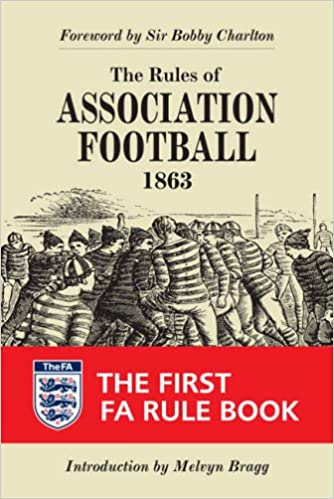
However, it would take a few decades before football seriously began to gain supporters in Sweden. When it happened, the message was very clear; this was a game for men, not women, or as the Malmö-based sports magazine Sport emphasized in 1891:
"If any sport in front of others can be said to be for men only, then it must be the game of football. No one else demands more of their practitioners that they develop all the qualities of man, such as strength, courage and determination, and, as far as possible, insensitivity to blows and shocks, and one can therefore understand why this game in two of the most masculine nations in the world, the English and the Scots, occupy such a prominent place among their innumerable sports games.”
Pärk, rugby and Swedish football
In Sweden, unlike in England, there was no tradition of so-called folk football, but of other ball games - for example pärk, which was practiced on Gotland. During the late 1870s, as the sports exchange with England began, knowledge of the new ball games also came over to Sweden.
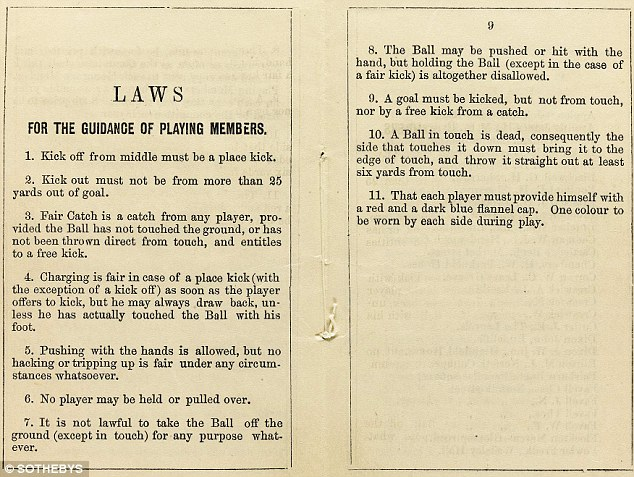
However, the dividing lines between football and rugby were not very sharp at first - in some places they used the round football, while others played with the oval rugby ball.
Ball clubs were formed, but it was not until 1885 that they had come so far in development that there was a need for common rules of the game. At the initiative of three of the country's leading ball clubs - in Stockholm, Gothenburg and Visby - a rulebook was established for "Swedish football", which was simply a mix of football and rugby. The Swedish ball kicks would thus bet on a very own variant of the football game.
However, the Swedish game model of football would not be very long-lived, as the somewhat confused interpretation of the rules posed problems. Among the schools in Stockholm, the game of football was encouraged, but each school played according to its own rules. A football competition between the various educational institutions in the capital, for example, could not be held in 1886 because the schools could not agree on which rules would apply.
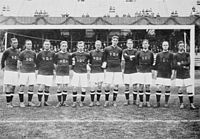
English football came via Denmark
Slowly but surely the English version of football began to make its entrance and the first strongholds did not get it unexpectedly in southwest Sweden, in Skåne. Football had already reached Denmark in the 1870s, and in 1890 the football clubs in Copenhagen carried out two important missionary missions to the neighbouring country. On September 14, 1890, the first international football match in Sweden was played at Tivoli square in Halmstad.

The year before, on May 5, 1889, "a ball game club according to the English pattern" had been formed in Halmstad. Halmstads bollklubb - which, however, has no common history with today's Halmstads Bollklubb - had in the summer of 1890 reached such a skill in the football game that an internal tournament was arranged and on 14 September, the Copenhagen Academy Boldklub came to visit.
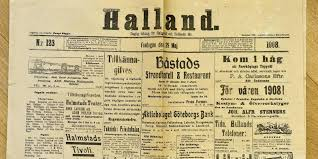
Report from the historic game
About this historic match, the newspaper Halland wrote:
The football competition… that took place here between eleven members of Copenhagen Academy Boldklub and eleven of Halmstads Bollklubb, had gathered a couple of thousand interested spectators to the competition venue next to Tivoli square, where everything was in the best order.
That the victorious Danes, who constituted a well-trained and trained elite corps from the Copenhagen Academy Boldklub, which counts 170 active members, would be superior to the relatively newly formed small Halmstad club, must already be assumed in advance. They were also equipped with a suitable suit and footwear for the game with thick soles, which enabled huge long kicks, and they played with a calculation and constant cooperation, which can only be achieved through many years of practice.
But the ball kicks from Halmstad were strongly opposed.
That this was the first international match is undisputed, however, there is some uncertainty as to whether they really played by the modern football rules. An article in 1891 in Ny tidning för idrott about Halmstad's ball club's activities raises some questions about the rules of the game that were applied in the historic match.
Malmö Velocipede club predecessor
Regarding the aftermath of Danish AB's visit, the newspaper writes:
However, the game was now almost completely transformed. New rules, namely those used by the football clubs in Copenhagen were adopted and more suitable footwear was procured instead of previously used soft rubber shoes, with which it was of course impossible to achieve any beautiful or advantageous kicks.
On the other hand, it is quite clear that the show match that two teams from the Copenhagen Bold Club gave in Malmö on October 12, 1890 was played according to the modern rulebook. The prehistory of that match provides an interesting insight into how modern football was introduced in Sweden.
It started with some football enthusiasts in the circle around Malmö Velocipede Club in the autumn of 1890 writing a letter to the Copenhagen Ball Club:
We intend to introduce the football game in Malmö.
Would you consider sending over the club's statutes and rules of the game?
The reply letter from KB contained not only the rules for the football game but also an offer: to come over to Malmö for a show match.
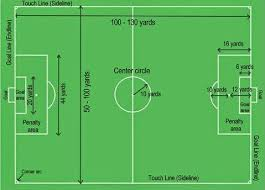
Modern football rules in print 1890
On October 11, 1890, Sydsvenska Dagbladet had a small, one-column ad on the front page, which stated that "The show in football games" would take place the next day on Malmö Velocipedklub's court - inaugurated earlier the same year and considered Sweden's first modern sports venue. And in an article the same day, the newspaper noted: "The football game is now being introduced with us, of course by the Danes, who are currently superior to us in all sports."
The football show on October 12 was a clear success. About a thousand Malmö residents steered the steps to MVK's pitch, whose inner field for the day was transformed into a football pitch. That the 22 Danish football players really did propaganda for the new game could be deduced from the fact that already a few days later, MVK's ball game department was formed.
The Danish guests had generously left behind two footballs and the printed set of rules for the game. MVK had the rules for "association-Fotbollspel" translated, which was published by Gleerupska pappershandelns förlag in October 1890. It was the first time that the rules of modern football were published in Swedish.
Football getting big in Malmö
That the novelty in Malmö sports required a lot of football players was stated in an article in 1891 in the magazine Sport, in which the following information was provided about the training during MVK's ball game department:
The unfamiliar and violent game caused most people to find it difficult to move their legs even after an hour, but it got even worse the next day: then you saw here and there young men, who with miserable faces and nervous twitches in their limbs. reminded of worn out cabs - it was football players from yesterday. A couple of them had even simply preferred to lie at home with ice blisters on their legs. Some muscles had become so sore that it hurt in them, just looking at them.
In Malmö, they really completely took to "association football" - not only in terms of the rules, but also in the choice of playing period. In England, football had become the sport of the winter season - this to distinguish it from the cricket sport's playing period during the summer - and also in Malmö, the game was introduced as a suitable winter sport.
It appears from the following statement in Sport in October 1891:
The season for football games is now in, and it would be hoped that this beautiful sport got even more practitioners this year than last year. It is almost the only outdoor sport that can be practiced regardless of the weather. Only too much snow, rain or sleet prevents games, which are always lively enough to keep players warm and make them forget if the weather is beautiful or less beautiful.
Scottish workers in Gothenburg
It is interesting to note the regional differences for the entry of football in Sweden. In Gothenburg, the English influence was palpable. Admittedly, Gothenburg's ball club had been formed as early as 1875, but it had mostly dealt with the Swedish version of football, which was otherwise referred to as the "kicking, running and shooting game".
It was not until the early 1890s that Gothenburg came into real contact with modern football and this was done mainly through Scottish textile workers. The Swedish textile factory in Gothenburg had borrowed over a number of skilled scots for production. In their spare time, the scots visited the nearby sports ground.
Among the scottish textile workers there were several skilled football players and these now took the opportunity to teach the game to the ball-kicking Swedes. Soon, these scots formed the backbone of Örgryte's football team.
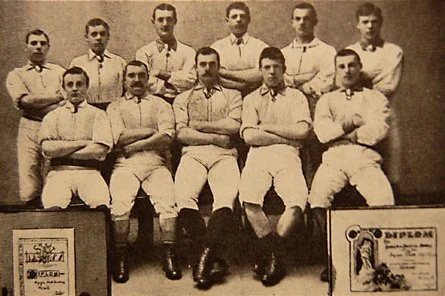
Örgryte against Lyckans Soldater
At the same time, another sports association in Gothenburg, the Lyckas Soldater, took up the game of football. The club's secretary, Ernst Roberg, had during a long period of work in England come into contact with modern football and also brought home to Gothenburg. Under Roberg's leadership, Lyckans Soldater began training football at Heden.
It was also Örgryte and Lyckans Soldater who made up the team when the first "real" football match was played between two swedish teams. During the Gymnastics and Sports Festival in Gothenburg, they met in a football match with the "Association rules" at Heden on May 22, 1892.
The Gothenburg trade and shipping magazine wrote about the historic match:
11 men from each of Idrottssällskapet Lyckans Soldater and Örgryte Idrottssällskap participated in the game. Among the latter Society's teams were six Scots who showed their skill in the game far superior to the Swedish participants.
The skilled football players from Scotland had an enormous propaganda value. Already the year after the first match, Gothenburg had up to a thousand football players in about twenty clubs. Not least Örgryte's matches constantly attracted new players to football and Örgryte retained its superiority.
In a match against Lyckans Soldater on June 15, 1893, seven scots were found in Örgryte's team, who at Heden won with "six goals" against zero, as shown by the preserved referee record, which also reports that the match:
lasted 1 hour with a 10 minute break at goal exchange.
From 1895 the rules of association applied
The English version of football gained more and more ground at the expense of the Swedish. By the mid-1890s, Swedish football had played its part. From 1895, the so-called "association rules" applied throughout Sweden.
Gothenburg maintained its leading position, but also cities such as Gävle, Eskilstuna, Västerås and Köping formed early strongholds. Football had come to Köping as early as 1890. The pattern was the same as in Gothenburg. Some workers from Australia had that year been given temporary employment at Köping's mechanical workshop and introduced the game to their Swedish comrades.
In Stockholm, the football game only gained momentum after the twin clubs AIK and Djurgården, both formed in 1891, began to take an interest in the game. AIK took up football on its program in the summer of 1896 and Djurgården formed its first football team in 1899.
Örgryte first Swedish champions 1896
By then, the first Swedish champions in football had already been crowned. The Swedish Sports Confederation had been founded in Gothenburg in 1895 and under the auspices of this federation, the first Swedish Championship competitions were held in free sports and football the following year. In the statutes for the competitions, which took place in Helsingborg in August 1896, it was clearly stated that the football tournament would be played according to the English rules.
Örgryte - now with only Swedish players in the team - did not unexpectedly win the first Swedish Championship sign by defeating another Gothenburg team, the Friends of Sports Society, 3-0 in the final.
In the Swedish Championship tournament in 1897, which was decided in Gothenburg, Örgryte emphasized his special position in Swedish football. In the final, ÖIS won over their own reserve team with 1-0! In the following two years, Örgryte was able to claim the Swedish championship in football.
AIK champion after a match
The Gothenburg team's total dominance was broken in 1900, when AIK sensationally defeated Örgryte in the Swedish Championship final at Lindarängen in Stockholm with 1-0. The team from Solna also managed to defend their Swedish Championship gold the following year, despite the tournament taking place in Gothenburg. However, this championship was conquered in an extremely strange way.
In the semifinals, which were played earlier in the day, AIK had defeated Örgryte's first team 3-0, while Örgryte's reserve team went to the final without a match. As the simultaneous Swedish Championships in athletics dragged on, the evening darkness began to descend over the arena.
No football final was therefore played, but AIK was named Swedish champions after the following reasoning in the competition management: Solnalaget had defeated Örgryte's A-team in the semifinals and the first team should reasonably be better than the second team!
Gefle took him from Rosen's trophy
The years around the turn of the last century saw the definitive breakthrough of football in Sweden. In 1899, the very football-interested Count Clarence von Rosen set up a trophy, which was the prize in a national football competition.
Gefle IF got the first mortgage in the cup in 1899 after defeating both Djurgården and AIK in Stockholm. Clarence von Rosen also made sure that football in 1900 got its own mouthpiece in the magazine Nordiskt idrottslif, whose columns were filled with articles about the popular game.
Power struggle national sport against football
In more and more places around the country, football matches were organized, which in turn led to the formation of local clubs. Not least during the year 1901, a number of new football clubs were added. Swedish football grew so fast that as early as 1902 there was a need for a national organization. At that time, the Swedish Ball Games Association was formed, but the organization mostly operated in Stockholm and Uppland.
When the Swedish National Sports Federation was formed in 1903, the goal was to gather all sports in the country, but they did not succeed in reaching an agreement with the Swedish Ball Games Federation. As a result, the Swedish Sports Confederation in April 1904 appointed a section board for football and bandy with Clarence von Rosen as chairman.
Thus, it was ready for the first real power struggle in the history of Swedish football: the Swedish Ball Games Association against the Swedish Sports Confederation's football section. Who would have the power?
On December 18, 1904, the decisive battle was fought. Under the chairmanship of Viktor Balck, the two warring organizations and representatives from the clubs held a meeting at GCI in Stockholm. All speakers agreed on the need for unity within the football team. However, the vote became a real drama. The RF phalanx won with a paltry three votes, 40 against 37.
Sweden member of Fifa 1907
The wording of paragraph 4 in the minutes of this meeting has been regarded as something of a memorandum of association for the entire Swedish football movement: “The meeting therefore states as its opinion that the right way to resolve the battle that has prevailed in the football world so far is that the associations , which has not yet joined the Swedish Sports Confederation, will do so as soon as possible, and that the football-playing associations will be arranged mainly with a plan published by the Swedish Sports Confederation's football section. ”
But that was only a margin of three votes. However, the Swedish Ball Games Association did not give up immediately and they refused, among other things, to drop their name. Due to two rival federations, Sweden could not be admitted as a full member of the International Football Association (Fifa), which was formed in Paris in 1904.
Two years later, however, the Folspelsförbundet closed down its activities. RF's football section could thus officially call itself the Swedish Football Association and was elected in 1907 as a full member of Fifa.